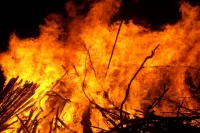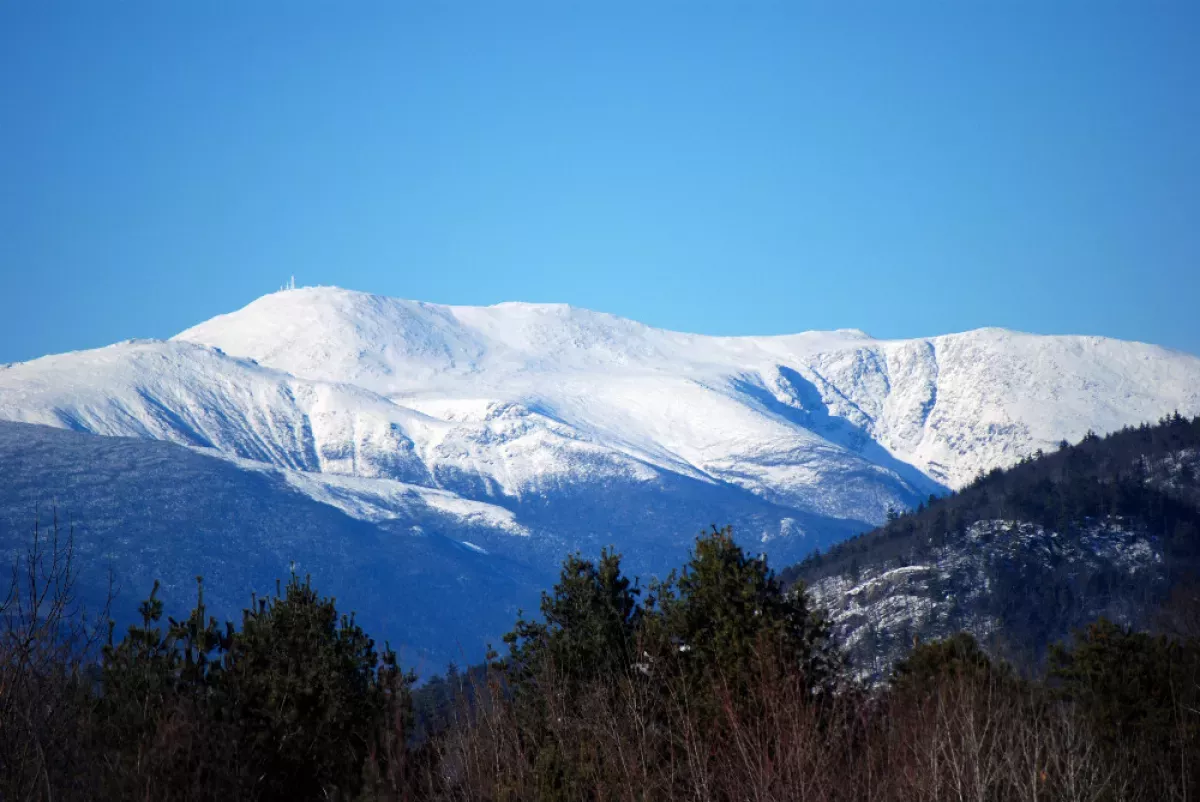Mount Washington, standing tall at 6,288.2 feet (1,916.6 meters), reigns supreme as the highest peak in the Northeastern United States. Located in New Hampshire, it claims the title of the most topographically prominent mountain east of the Mississippi River, making it a true giant of the eastern landscape.
June 30, 1900: Death of William Buckingham Curtis
On June 30, 1900, William Buckingham Curtis, considered "the father of American amateur athletics," tragically died from exhaustion near Lakes of the Clouds Hut during a summer snowstorm on Mount Washington.
1904: First Mount Washington Hillclimb Auto Race
The first Mount Washington Hillclimb Auto Race, one of the oldest car races in the US, took place in 1904.
1908: Summit House Fire
The Summit House, a 91-room wooden hotel, burned down in 1908. It was subsequently rebuilt in granite in 1915.
1915: Summit House Rebuilt
The Summit House, which had burned down in 1908, was rebuilt in granite in 1915.
1917: End of "Among the Clouds"
After forty years of intermittent publication, the daily newspaper "Among the Clouds", published by Henry M. Burt, ceased publication in 1917.
1931: First Ski Descents in Tuckerman Ravine
In 1931, Dartmouth students John Carleton and Charles Proctor became the first to ski down Tuckerman Ravine's headwall. They were soon followed by a group from Harvard who skied the headwall from Mount Washington's summit. This marked the beginning of Tuckerman Ravine's rise as a major destination for extreme skiing in New England.
August 7, 1932: First One-Legged Ascent
On August 7, 1932, Raymond E. Welch made history by becoming the first one-legged man to climb Mount Washington, completing the challenging "Jacob's Ladder" route.
1932: Mount Washington Observatory Founded
The Mount Washington Observatory was built in 1932 to study the mountain's extreme weather conditions and has been collecting weather data ever since.
January 1934: Record Low Temperature Tied
The -47 °F temperature recorded on the morning of February 4, 2023, tied the previous record low observed in January 1934.
January 29, 1934: Previous Record Low Temperature
While later surpassed, January 29, 1934, held the record for the lowest temperature recorded on Mount Washington for many years, at -47 °F (-43.9 °C).
April 12, 1934: World Record Windspeed
On April 12, 1934, the Mount Washington Observatory recorded a windspeed of 231 miles per hour (372 km/h), setting a world record that stood until 1996.
1937: W1XER Relocates to Mount Washington
In 1937, the "Apex" radio station W1XER was moved from Boston to Mount Washington, initially intended to relay weather data from the observatory, marking the beginning of the mountain's significant role in broadcasting.
1937: First Giant Slalom Race in the US
Mount Washington hosted the inaugural giant slalom race in the United States, the Franklin Edson Memorial Race, in 1937.
1938: Early Experimental Radio Stations
By 1938, Mount Washington was already home to at least five experimental radio stations, taking advantage of its height for VHF transmissions, which offered line-of-sight coverage.
December 19, 1940: W1XER Begins Regular FM Broadcasts
After a challenging conversion process, experimental station W1XER, originally an AM "Apex" station relocated from Boston to Mount Washington in 1937, commenced regular FM broadcast programming on December 19, 1940, pioneering FM broadcasting from the mountain.
1940: "World's Worst Weather" Claim
The claim that Mount Washington has the "World's Worst Weather" originated in a 1940 article in Appalachia magazine by Charles Brooks, a key figure in the establishment of the Mount Washington Observatory.
April 5, 1941: W1XER Transitions to Commercial FM Broadcasting
On April 5, 1941, W1XER, known as W39B at the time, began commercial FM broadcasting from Mount Washington, marking an important milestone in the mountain's history as a broadcasting hub.
November 1, 1943: W39B Becomes WMTW
On November 1, 1943, W39B, broadcasting from Mount Washington, underwent a call sign change to WMTW, continuing its legacy as a prominent FM station.
1946: WMTW Becomes WMNE
In 1946, WMTW, broadcasting from Mount Washington, underwent another call sign change, becoming WMNE, continuing its run as a key FM station in the region.
October 1947: Lowest Monthly Precipitation
The lowest monthly precipitation recorded on Mount Washington was 0.75 inches (19.1 mm) in October 1947.
1948: WMNE Cease Operations
In 1948, WMNE, broadcasting from Mount Washington, ceased operations due to high maintenance costs and concerns about reduced transmission range after a mandated frequency change to the new FM "high band." This event marked a turning point in the mountain's early broadcasting history.
1948: Armstrong Tower Used for Broadcasts Again
With the installation of a new standby antenna on the Armstrong tower for WHOM, the tower was utilized for broadcasting for the first time since 1948, marking a return to its historical use.
1958: WMTW-FM Begins Broadcasting
The year 1958 saw the establishment of WMTW-FM 94.9 MHz (now known as WHOM) on Mount Washington, further solidifying the mountain's status as a broadcasting hub.
1968: Year Before Record Snowfall
The winter of 1968-1969 saw record snowfall on Mount Washington, with a seasonal accumulation of 566.4 inches (14.39 m). The previous year, 1968, likely saw significant snowfall leading up to the record.
February 1969: Record 24-Hour Snowfall
The highest 24-hour snowfall ever recorded on Mount Washington was 49.3 inches (125.2 cm) in February 1969.
August 2, 1975: Record High Temperature (Tied)
August 2, 1975, is tied with June 26, 2003, for the highest temperature ever recorded on Mount Washington, at 72 °F (22.2 °C).
1979: Lowest Annual Precipitation
Mount Washington experienced its lowest annual precipitation in 1979, receiving only 71.34 inches (1,812.0 mm).
1987: WMOU Moves to Mount Washington
In 1987, WMOU (currently WPKQ) relocated to Mount Washington, installing transmitters in the Yankee building and erecting a new broadcast tower behind it, marking a significant addition to the mountain's broadcasting infrastructure.
February 6, 1995: Record Low Daily Maximum Temperature
The coldest daily maximum temperature ever recorded on Mount Washington was -28 °F (-33.3 °C) on February 6, 1995.
October 1996: Record 24-Hour Precipitation
In October 1996, Mount Washington received a record 11.07 inches (281.2 mm) of precipitation within a single 24-hour period.
2000: "Not Without Peril" Publication
Author Nicholas Howe's book "Not Without Peril," published in 2000, documented numerous fatalities on Mount Washington, shedding light on the mountain's hazardous nature.
2002: WMTW-TV Relocates Transmitter
In 2002, WMTW-TV relocated its transmitter away from Mount Washington. This decision was driven by concerns that the mandatory transition from analog to digital broadcasting would lead to inadequate coverage if the transmitter remained at the summit.
February 9, 2003: Major Fire Disrupts Mount Washington Transmissions
A significant fire on February 9, 2003, caused major disruption to Mount Washington's transmission facilities. The fire originated in the generator room of the transmitter building, destroying the building, including WHOM's transmitters and the summit's primary generators. The fire also spread to the nearby Old Yankee Power House, housing the emergency generator, further escalating the damage and cutting off all power to the summit. Temporary generators were brought in to restore power to essential services like the observatory and the Yankee building, highlighting the vulnerability of the mountain's infrastructure.
June 26, 2003: Record High Temperature
The highest temperature ever recorded on Mount Washington was 72 °F (22.2 °C) on both June 26, 2003, and August 2, 1975.
2003: Mount Washington as a Transmission Hub
A report in 2003 highlighted the importance of Mount Washington's summit as a site for various transmission stations. Due to its high elevation and broad coverage, it housed three commercial radio stations, along with numerous state, federal, and private agencies, including the state police.
January 16, 2004: Extreme Wind Chill
On January 16, 2004, Mount Washington experienced a wind chill of -102.59 °F (-74.8 °C) due to a combination of low temperatures (-43.6 °F) and high winds (87.5 mph).
October 2005: Highest Monthly Precipitation
The highest monthly precipitation recorded on Mount Washington was 28.70 inches (729.0 mm) in October 2005.
2005: National Landmark of Soaring
Mount Washington was recognized as the 14th National Landmark of Soaring in 2005 due to its unique weather conditions favorable for glider flying.
June 2008: Potential Television Comeback on Mount Washington
In June 2008, New Hampshire Public Television filed a request to move WLED-TV from Littleton to the former WMTW mast on Mount Washington, signaling a potential revival of television broadcasting from the summit.
2009: Discovery of 1996 Wind Record
A new world record wind speed, measured during Tropical Cyclone Olivia on April 10, 1996, was discovered in 2009 through data analysis.
2009: "Not Without Peril" Updated Edition
In 2009, Nicholas Howe's book "Not Without Peril" was re-released with updates. The updated edition emphasized that many deaths on Mount Washington over the years were due to a lack of proper planning and a misunderstanding of the stark weather differences between the mountain and lower elevations.
2009: Grid Power Reaches Mount Washington Summit
In 2009, a significant infrastructure upgrade brought grid power to the summit of Mount Washington for the first time, marking a new era of stability and reliability for facilities at the top.
2010: Pastrana's First Record
Travis Pastrana set his first record at the Mount Washington Hillclimb Auto Race in 2010, driving a Subaru WRX STi.
2011: Trademark Dispute Begins
In 2011, CNL Financial Group, which operated the Mount Washington Hotel, began trademarking the "Mount Washington" name for resort and hotel use, sparking controversy.
2012: Trademark Dispute Continues
CNL Financial Group continued its efforts to trademark the "Mount Washington" name for resort and hotel use in 2012, focusing on hotels rather than other businesses.
2014: Pastrana's Second Record and First EV Competitor
2014 saw Travis Pastrana break his own record at the Mount Washington Hillclimb Auto Race. This year was also significant for being the first year an electric vehicle competed, with Tim O'Neil driving the Entropy Racing EVSR.
2017: Pastrana's Third Record
Travis Pastrana once again set a new record at the Mount Washington Hillclimb Auto Race in 2017, continuing his dominance in the event.
2019: Fatalities in the Presidential Range
By 2019, records showed over 161 fatalities in the Presidential Range since record-keeping began in 1849, highlighting the inherent dangers of the mountain environment.
2021: Pastrana's Fourth Record
Travis Pastrana secured his fourth victory and record at the Mount Washington Hillclimb Auto Race in 2021, solidifying his legacy at the event.
February 4, 2023: Record Low Windchill
On February 4, 2023, Mount Washington set a new US record low windchill temperature of -108 °F (-77.8 °C) due to wind gusts exceeding 100 mph and a temperature of -47 °F. This temperature reading also tied the coldest temperature in 89 years.
Mentioned in this timeline
Australia officially the Commonwealth of Australia encompasses the Australian mainland...

Travis Pastrana is an American professional athlete celebrated for his...

A car also known as an automobile is a wheeled...

Books are a means of storing information as text or...
Poland officially the Republic of Poland is a Central European...

Fire is a rapid oxidation process called combustion releasing heat...
Trending
2 months ago Kansas Jayhawks face UCF Knights: Sorsby's performance crucial in Big 12 matchup.
Jaylen Warren is a professional American football running back currently playing for the Pittsburgh Steelers in the NFL He had...

7 months ago Michelle Obama Reveals Barack's Joke After Her Mother's Death and Pope's Viewing Habits.

Tony Dow was a renowned American actor producer director and sculptor best known for his role as Wally Cleaver in...
2 months ago IREN Stock Surges on AI Cloud Deals and Bitcoin Mining Integration.
10 days ago Lawsuit Filed Over KISD Stabbing; Killeen Principal Resigns From Ira Cross
Popular

Candace Owens is an American conservative political commentator and author...

Ilhan Omar is an American politician currently serving as the...

XXXTentacion born Jahseh Dwayne Ricardo Onfroy was a controversial yet...

Frederick Christ Trump Sr - was an American real estate...

Oprah Winfrey an American talk show host television producer actress...

Tom Cotton is an American politician and Army veteran currently...
